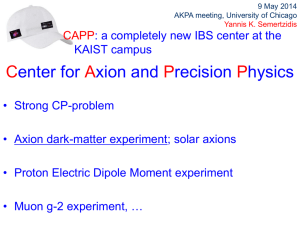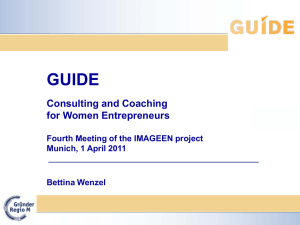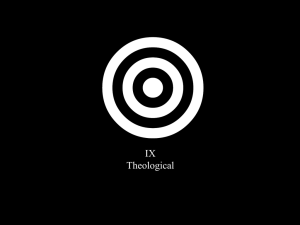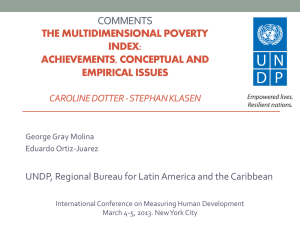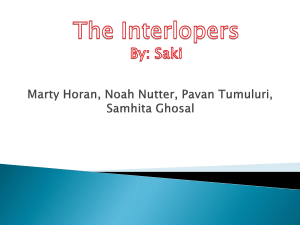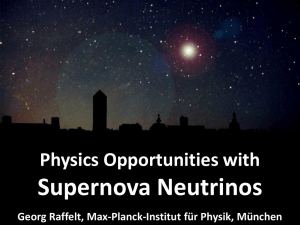Axions as Dark Matter - Max-Planck
advertisement
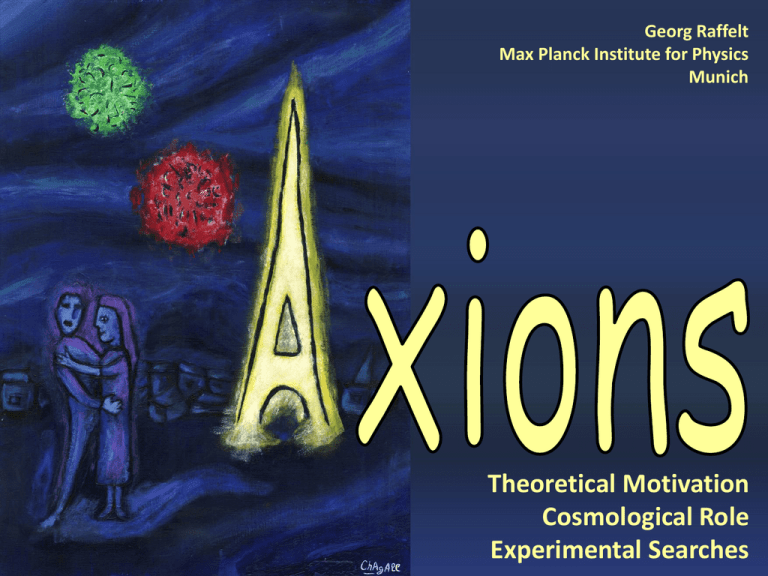
Axions Georg Raffelt, MPI Physics, Munich Georg Raffelt Max Planck Institute for Physics Munich Theoretical Motivation Cosmological Role Experimental Searches ISAPP, Heidelberg, 15 July 2011 Axion Physics in a Nut Shell Particle-Physics Motivation CP conservation in QCD by Peccei-Quinn mechanism p0 Axions a ~ mpfp mafa g Axions thermally produced in stars, e.g. by Primakoff production g a a For fa ≫ fp axions are “invisible” and very light Cosmology In spite of small mass, axions are born non-relativistically (non-thermal relics) Cold dark matter candidate ma ~ 10 meV or even smaller Georg Raffelt, MPI Physics, Munich Solar and Stellar Axions g • Limits from avoiding excessive energy drain • Solar axion searches (CAST, Sumico) Search for Axion Dark Matter N Microwave resonator (1 GHz = 4 meV) g a Primakoff conversion S Bext ADMX (Seattle) New CARRACK (Kyoto) ISAPP, Heidelberg, 15 July 2011 Axions Particle-Physics Origins Georg Raffelt, MPI Physics, Munich ISAPP, Heidelberg, 15 July 2011 CP Violation in Particle Physics Discrete symmetries in particle physics C – Charge conjugation, transforms particles to antiparticles violated by weak interactions P – Parity, changes left-handedness to right-handedness violated by weak interactions T – Time reversal, changes direction of motion (forward to backward) CPT – exactly conserved in quantum field theory CP – conserved by all gauge interactions violated by three-flavor quark mixing matrix All measured CP-violating effects derive from a single phase in the quark mass matrix (Kobayashi-Maskawa phase), i.e. from complex Yukawa couplings Cosmic matter-antimatter asymmetry requires new ingredients M. Kobayashi T. Maskawa Physics Nobel Prize 2008 Georg Raffelt, MPI Physics, Munich ISAPP, Heidelberg, 15 July 2011 Cabbibo-Kobayashi-Maskawa (CKM) Matrix Quark interaction with W boson (charged-current electroweak interaction) 𝑔 2 Ψ𝑢𝐿 𝛾 𝜇 𝑉CKM Ψ𝑑𝐿 𝑊𝜇+ + h. c. Ψ𝑢 = (𝑢, 𝑐, 𝑡) Unitary Cabbibo-Kobayashi-Maskawa matrix relates mass eigenstates to weak interaction eigenstates 𝑉CKM 𝑉𝑢𝑑 = 𝑉𝑐𝑑 𝑉𝑡𝑑 Ψ𝑑 = (𝑑, 𝑠, 𝑏) 𝑉𝑢𝑠 𝑉𝑐𝑠 𝑉𝑡𝑠 𝑉𝑢𝑏 𝑉𝑐𝑏 𝑉𝑡𝑏 VCKM depends on three mixing angles and one phase d, explaining all observed CP-violation Precision tests use “unitarity triangles” consisting of products of measured components of VCKM, for example: Georg Raffelt, MPI Physics, Munich ISAPP, Heidelberg, 15 July 2011 Measurements of CKM Unitarity Triangle CKMfitter Group http://ckmfitter.in2p3.fr Georg Raffelt, MPI Physics, Munich UTfit Collaboration http://www.utfit.org ISAPP, Heidelberg, 15 July 2011 Kobayashi and Maskawa Georg Raffelt, MPI Physics, Munich ISAPP, Heidelberg, 15 July 2011 The CP Problem of Strong Interactions Real quark mass ℒQCD = 𝜓𝑞 i𝐷 − 𝑚𝑞 𝑒 Phase from Yukawa coupling i𝜃𝑞 𝜓𝑞 − Angle variable 𝜇𝜈 1 4 𝐺𝜇𝜈𝑎 𝐺𝑎 𝑞 CP-odd quantity ∼ 𝐄 ⋅ 𝐁 𝛼s 𝜇𝜈 −Θ 𝐺𝜇𝜈𝑎 𝐺𝑎 8𝜋 Remove phase of mass term by chiral transformation of quark fields 𝜓𝑞 → 𝑒 −𝑖𝛾5 𝜃𝑞 /2 ℒQCD = 𝜓𝑞 𝜓𝑞 i𝐷 − 𝑚𝑞 𝜓𝑞 − 14 𝐺𝐺 𝑞 − Θ − arg det 𝑀𝑞 −𝜋 ≤Θ≤+𝜋 𝛼s 𝐺𝐺 8𝜋 Θ can be traded between quark phases and 𝐺 𝐺 term No physical impact if at least one 𝑚𝑞 = 0 Induces a large neutron electric dipole moment (a T-violating quantity) Experimental limits: Georg Raffelt, MPI Physics, Munich 𝚯 < 𝟏𝟎−𝟏𝟏 Why so small? ISAPP, Heidelberg, 15 July 2011 Neutron Electric Dipole Moment Violates time reversal (T) and space reflection (P) symmetries Natural scale 𝑒 = 1.06 × 10−14 𝑒 cm 2𝑚𝑁 Experimental limit 𝑑 = 0.63 × 10−25 𝑒 cm Limit on coefficient 𝑚𝑞 Θ ≲ 10−11 𝑚𝑁 Georg Raffelt, MPI Physics, Munich ISAPP, Heidelberg, 15 July 2011 Strong CP Problem QCD vacuum energy 𝑉(Θ) Λ4QCD Equivalent Equivalent −2𝜋 −𝜋 +𝜋 +2𝜋 Θ • CP conserving vacuum has Θ = 0 (Vafa and Witten 1984) • QCD could have any −𝜋 ≤ Θ ≤ +𝜋, is “constant of nature” • Energy can not be minimized: Θ not dynamical Peccei-Quinn solution: Make Θ dynamical, let system relax to lowest energy Georg Raffelt, MPI Physics, Munich ISAPP, Heidelberg, 15 July 2011 Dynamical Solution Peccei & Quinn 1977, Wilczek 1978, Weinberg 1978 • Re-interpret Θ as a dynamical variable (scalar field) 𝛼s 𝛼s 𝑎(𝑥) ℒCP = − Θ Tr 𝐺 𝐺 → − Tr 𝐺 𝐺 8𝜋 8𝜋 𝑓𝑎 𝑎(𝑥) is pseudoscalar axion field, 𝑓𝑎 axion decay constant (Peccei-Quinn scale) • Axions generically couple to two gluons and mix with, 𝜋0, 𝜂, 𝜂 ′ mesons, inducing a mass (potential) for 𝑎(𝑥) 𝑚𝑢 𝑚𝑑 𝑓𝜋 Axion mass Pion mass 𝑚𝑎 𝑓𝑎 = 𝑚 𝑓 ∼ × & couplings & couplings 𝑚𝑢 + 𝑚𝑑 𝜋 𝜋 𝑓𝑎 • Potential (mass term) induced by ℒCP drives 𝑎(𝑥) to CP-conserving minimum 𝑉(𝑎) CP-symmetry dynamically restored 𝑎 Θ=0 Georg Raffelt, MPI Physics, Munich ISAPP, Heidelberg, 15 July 2011 The Pool Table Analogy (Pierre Sikivie 1996) Gravity Pool table Symmetric relative to gravity Axis Floor inclined Symmetry broken fa New degree of freedom Axion (Weinberg 1978, Wilczek 1978) Georg Raffelt, MPI Physics, Munich 𝚯 Symmetry dynamically restored (Peccei & Quinn 1977) ISAPP, Heidelberg, 15 July 2011 33 Years of Axions Georg Raffelt, MPI Physics, Munich ISAPP, Heidelberg, 15 July 2011 The Cleansing Axion Frank Wilczek “I named them after a laundry detergent, since they clean up a problem with an axial current.” (Nobel lecture 2004) Georg Raffelt, MPI Physics, Munich ISAPP, Heidelberg, 15 July 2011 Axion as a Nambu-Goldstone Boson 𝛼𝑠 αs 𝑎(𝑥) ℒCP = Θ𝐺𝑎 𝐺𝑎 → Θ− 𝐺𝑎 𝐺𝑎 8𝜋 8π 𝑓𝑎 Periodic variable (angle) Φ= 𝑓𝑎 + 𝜌 𝑥 2 𝑖𝑎 𝑥 𝑒 𝑓𝑎 • New U(1) symmetry, spontaneously broken at a large scale 𝑓𝑎 • Axion is “phase” of new Higgs field: angular variable 𝑎(𝑥)/𝑓𝑎 • By construction couples to 𝐺 𝐺 term with strength 𝛼𝑠/8𝜋, e.g. triangle loop with new heavy quark (KSVZ model) • Mixes with 𝜋0-𝜂-𝜂 ′ mesons • Axion mass (vanishes if 𝑚𝑢 or 𝑚𝑑 = 0) Georg Raffelt, MPI Physics, Munich 𝑚𝑢 𝑚𝑑 𝑚𝜋 𝑚𝑎 = 𝑚𝑢 + 𝑚𝑑 𝑓𝜋 𝑓𝑎 ISAPP, Heidelberg, 15 July 2011 From Standard to Invisible Axions Invisible Axion Standard Model All Higgs degrees of freedom are used up “Standard Axion” Weinberg 1978, Wilczek 1978 • Peccei-Quinn scale fa = fEW (electroweak scale) • Two Higgs fields, separately giving mass to up-type quarks and down-type quarks No room for Peccei-Quinn Standard axions quickly symmetry and axions ruled out experimentally Georg Raffelt, MPI Physics, Munich Kim 1979, Shifman, Vainshtein, Zakharov 1980, Dine, Fischler, Srednicki 1981 Zhitnitsky 1980 • Additional Higgs with fa ≫ fEW • Axions very light and and very weakly interacting • New scale required • Axions can be cold dark matter • Can be detected ISAPP, Heidelberg, 15 July 2011 Simplest Invisible Axion: KSVZ Model Ingredients: Scalar field Φ, breaks U(1)PQ spontaneously Very heavy colored quark with coupling to Φ, provides 𝑎𝐺 𝐺 term 𝑖 ℒKSVZ = Ψ𝜕𝜇 𝛾 𝜇 Ψ + h. c. + 𝜕𝜇 Φ† 𝜕𝜇 Φ − 𝑉 Φ − ℎ ΨL ΨR Φ + h. c. 2 Invariant under chiral phase transformations (Peccei Quinn symmetry) Φ → 𝑒 𝑖𝛼 Φ, ΨL → 𝑒 𝑖𝛼 2 ΨL , ΨR → 𝑒 −𝑖𝛼 2 ΨR Mexican hat potential 𝑉( Φ ), expand fields as 𝑓𝑎 + 𝜌(𝑥) 𝑖𝑎(𝑥)/𝑓 𝑎 Φ(𝑥) = 𝑒 2 Low-energy Lagrangian ℒKSVZ = 𝑖 Ψ𝜕𝜇 𝛾 𝜇 Ψ 2 + h. c. + 1 2 𝜕𝜇 𝑎 2 − 𝑚Ψ𝑒 𝑖𝛾5 𝑎 𝑓𝑎 Ψ, where 𝑚 = ℎ𝑓𝑎 / 2 Lowest-order interaction term induces 𝑎𝐺 𝐺 term 𝛼𝑠 𝑎 ℒ𝑎𝐺 = − 𝐺𝐺 8𝜋 𝑓𝑎 Couples axion to QCD sector Georg Raffelt, MPI Physics, Munich ISAPP, Heidelberg, 15 July 2011 Axion Properties 𝛼𝑠 = 𝐺 𝐺𝑎 8𝜋𝑓𝑎 G Gluon coupling (generic) 𝐿𝑎𝐺 Mass (generic) 𝑚𝑢 𝑚𝑑 𝑚𝜋 6 𝜇eV 𝑚𝑎 = ≈ 𝑚𝑢 + 𝑚𝑑 𝑓𝜋 𝑓𝑎 𝑓𝑎 1012 GeV Photon coupling 𝑔𝑎𝛾 𝐿𝑎𝛾 = − 𝐹 𝐹𝑎 = 𝑔𝑎𝛾 𝐄 ⋅ 𝐁 𝑎 4 a 𝛼 𝐸 𝑔𝑎𝛾 = − 1.92 2𝜋𝑓𝑎 𝑁 Pion coupling Nucleon coupling (axial vector) Electron coupling (optional) Georg Raffelt, MPI Physics, Munich a G 𝐿𝑎𝜋 𝐶𝑎𝜋 0 + = 𝜋 𝜋 𝜕𝜇 𝜋 − + ⋯ 𝜕𝜇 𝑎 𝑓𝜋 𝑓𝑎 𝐿𝑎𝑁 𝐶𝑁 = Ψ𝑁 𝛾 𝜇 𝛾5 Ψ𝑁 𝜕𝜇 𝑎 2𝑓𝑎 𝐿𝑎𝑒 𝐶𝑒 = Ψ𝑒 𝛾 𝜇 𝛾5 Ψ𝑒 𝜕𝜇 𝑎 2𝑓𝑎 g g p p p a N a N e a e ISAPP, Heidelberg, 15 July 2011 Axions Astrophysical Bounds Georg Raffelt, MPI Physics, Munich ISAPP, Heidelberg, 15 July 2011 Axion Emission Processes in Stars Nucleons 𝐶𝑁 Ψ𝑁 𝛾𝜇 𝛾5 Ψ𝑁 𝜕𝜇 𝑎 2𝑓𝑎 Photons 𝐶𝛾 𝛼 1 𝐹𝜇𝜈 𝐹𝜇𝜈 𝑎 2𝜋𝑓𝑎 4 Nucleon Bremsstrahlung Primakoff Compton Electrons 𝐶𝑒 Ψ𝑒 𝛾𝜇 𝛾5 Ψ𝑒 𝜕𝜇 𝑎 2𝑓𝑎 Pair Annihilation Electromagnetic Bremsstrahlung Georg Raffelt, MPI Physics, Munich ISAPP, Heidelberg, 15 July 2011 Supernova 1987A Energy-Loss Argument SN 1987A neutrino signal Neutrino sphere Volume emission of new particles Neutrino diffusion Emission of very weakly interacting particles would “steal” energy from the neutrino burst and shorten it. (Early neutrino burst powered by accretion, not sensitive to volume energy loss.) Late-time signal most sensitive observable Georg Raffelt, MPI Physics, Munich ISAPP, Heidelberg, 15 July 2011 Diffuse Supernova Axion Background (DSAB) • Neutrinos from all core-collapse SNe comparable to photons from all stars • Diffuse Supernova Neutrino Background (DSNB) similar energy density as extra-galactic background light (EBL), approx 10% of CMB energy density • DSNB probably next astro neutrinos to be measured • Axions with 𝑚𝑎 ~ 10 meV near SN 1987A energy-loss limit • Provide DSAB with compable energy density as DSNB and EBL • No obvious detection channel Raffelt, Redondo & Viaux work in progress (2011) Georg Raffelt, MPI Physics, Munich ISAPP, Heidelberg, 15 July 2011 Do White Dwarfs Need Axion Cooling? No axions White dwarf luminosity function (number of WDs per brightness interval) With axion cooling (𝑚𝑎 ~ 5 meV near SN1987A limit) Isern, Catalán, García-Berro & Torres arXiv:0812.3043 Georg Raffelt, MPI Physics, Munich ISAPP, Heidelberg, 15 July 2011 Axion Bounds [GeV] fa 103 ma 106 keV 109 eV Tele Experiments scope 1012 meV meV CAST search range Too many events neV ADMX search range Too much hot dark matter Globular clusters (a-g-coupling) 1015 Too much cold dark matter (classic scenario) Classic region Anthropic region Too much energy loss SN 1987A (a-N-coupling) Georg Raffelt, MPI Physics, Munich ISAPP, Heidelberg, 15 July 2011 Axions Georg Raffelt, MPI Physics, Munich As Dark Matter ISAPP, Heidelberg, 15 July 2011 Lee-Weinberg Curve for Neutrinos and Axions Axions log(Ω𝑎) Ω𝑀 Non-Thermal Relics CDM 10 meV Neutrinos & WIMPs log(Ω𝑎) Thermal Relics HDM log(𝑚𝑎) 10 eV Thermal Relics HDM CDM Ω𝑀 log(𝑚𝜈 ) 10 eV Georg Raffelt, MPI Physics, Munich 10 GeV ISAPP, Heidelberg, 15 July 2011 Axion Hot Dark Matter from Thermalization after LQCD p p p a 𝐿𝑎𝜋 𝐶𝑎𝜋 0 + = 𝜋 𝜋 𝜕𝜇 𝜋 − + 𝜋 0 𝜋 − 𝜕𝜇 𝜋 + − 2𝜋 + 𝜋 − 𝜕𝜇 𝜋 0 𝜕𝜇 𝑎 𝑓𝑎 𝑓𝜋 Chang & Choi, PLB 316 (1993) 51 Hannestad, Mirizzi & Raffelt, hep-ph/0504059 Georg Raffelt, MPI Physics, Munich ISAPP, Heidelberg, 15 July 2011 Tegmark, TAUP 2003 Power Spectrum of Cosmic Density Fluctuations Georg Raffelt, MPI Physics, Munich ISAPP, Heidelberg, 15 July 2011 Neutrino and Axion Hot Dark Matter Limits Credible regions for neutrino plus axion hot dark matter (WMAP-7, SDSS, HST) Hannestad, Mirizzi, Raffelt & Wong [arXiv:1004.0695] Marginalizing over neutrino hot dark matter component 𝑚𝑎 < 0.7 eV (95% CL) 68% Georg Raffelt, MPI Physics, Munich 95% Assuming no axions ∑𝑚𝜈 < 0.4 eV (95% CL) ISAPP, Heidelberg, 15 July 2011 New BBN limits on sub-MeV mass axions • Axions essentially in thermal equilibrium throughout BBN • e+e- annihilation partly heats axions missing photons • Reduced photon/baryon fraction during BBN • Reduced deuterium abundance, using WMAP baryon fraction Cadamuro, Hannestad, Raffelt & Redondo, arXiv:1011.3694 (JCAP) Georg Raffelt, MPI Physics, Munich ISAPP, Heidelberg, 15 July 2011 Axion Bounds [GeV] fa 103 ma 106 keV 109 eV Tele Experiments scope 1012 meV meV CAST search range Too many events neV ADMX search range Too much hot dark matter Globular clusters (a-g-coupling) 1015 Too much cold dark matter (classic scenario) Classic region Anthropic region Too much energy loss SN 1987A (a-N-coupling) Georg Raffelt, MPI Physics, Munich ISAPP, Heidelberg, 15 July 2011 Axions As Cold Dark Matter Georg Raffelt, MPI Physics, Munich ISAPP, Heidelberg, 15 July 2011 Creation of Cosmological Axions 𝑻 ~ 𝒇𝒂 (very early universe) 𝑉(𝑎) • UPQ(1) spontaneously broken • Higgs field settles in “Mexican hat” • Axion field sits fixed at 𝑎𝑖 = Θ𝑖 𝑓𝑎 𝑻 ~ 𝟏 GeV (𝑯 ~ 𝟏𝟎−𝟗 eV) • Axion mass turns on quickly by thermal instanton gas • Field starts oscillating when 𝑚𝑎 ≳ 3𝐻 • Classical field oscillations (axions at rest) 𝑎 𝑉(𝑎) 𝑎 Θ=0 Axions are born as nonrelativistic, classical field oscillations Very small mass, yet cold dark matter Georg Raffelt, MPI Physics, Munich ISAPP, Heidelberg, 15 July 2011 Cosmic Axion Field Evolution (1) Scalar field evolution in the expanding universe, physical wave number 𝑘 Φ + 3HΦ + 𝑘 2 + 𝑚2 Φ = 0 𝜔2 Axion initially in 𝑘 = 0 mode, so 𝜔2 = 𝑚2 . For 3𝐻 ≫ 𝑚 no motion, for 3𝐻 ≪ 𝑚 Φ 𝑡 = Ψ 𝑡 sin(𝑚𝑡) with slowly changing amplitude Ψ 𝑡 . Insert in EoM, keep only fastest-moving terms 2𝑚Ψ + 3𝐻𝑚Ψ = 0 or 𝑑 1 𝑚Ψ 2 𝑑𝑡 2 number density = −3𝐻 𝑚 2 Ψ 2 A number density evolves with cosmic scale factor as 𝑛 ∝ 𝑅−3 , so 𝑛 = −3𝐻𝑛 Field amplitude decreases as Ψ = Θ𝑓𝑎 ∝ 𝑅−3 Our galaxy: 𝜌 ∼ 300 2 MeV/cm3 = 2.3 × Θ ∼ 2 × 10−19 sin 𝑚𝑎 𝑡 Georg Raffelt, MPI Physics, Munich 10−6 eV 4 1 2 2 2 1 2 2 2 = 𝑚𝑎 Θ 𝑓𝑎 ∼ Θ 𝑚𝜋 𝑓𝜋 2 2 ISAPP, Heidelberg, 15 July 2011 Searching for Axions in the Anthropic Window Assume axions are galactic dark matter: 𝜌𝑎 ~ 300 MeV/cm3 𝜌𝑎 = 𝑚𝑎2 Φ𝑎2 = 𝑚𝑎2 Θ𝑓𝑎 2 ∼ Θ2 𝑚𝜋 𝑓𝜋 2 ∼ Θ2 Λ4QCD Independently of 𝑓𝑎 expect Θ 𝑡 ∼ 3 × 10−19 cos 𝑚𝑎 𝑡 Expect time-varying neutron EDM, MHz frequency for 𝑓𝑎 ~ 1016 GeV 𝑒 mq 𝑑𝑛 ∼ Θ ∼ 3 × 10−34 𝑒−cm cos(𝑚𝑎 𝑡) 2𝑚𝑛 mN Experimental limit on static EDM 𝑑𝑛 < 0.63 × 10−25 𝑒−cm Use much larger electric fields within atoms, small energy shifts within polarized molecules: Molecular interferometry techniques may work, a factor ~ 100 off at present. Best in kHz-MHz regime (anthropic window). Graham & Rajendran, arXiv:1101.2691 Georg Raffelt, MPI Physics, Munich ISAPP, Heidelberg, 15 July 2011 Cosmic Axion Field Evolution (2) Today: Epoch 0. Axion field starts oscillating: Epoch 1. Present-day axion number density in terms of cosmic scale factors 3 𝑅1 𝑛0 = 𝑛1 𝑅0 Axion field starts oscillating when 𝑚1 ∼ 3𝐻1 and Ψ1 = Θ1 𝑓𝑎 1 3𝐻1 2 2 2 2 𝑛1 = 𝑚1 Θ1 𝑓𝑎 = Θ1 𝑓𝑎 2 2 Present-day mass density inversely proportional to axion mass \ 𝑅1 𝜌0 = 𝑚𝑎 𝑛0 = 𝑅0 3 3𝐻1 2 𝑓𝑎2 𝑚𝑎2 𝑅1 Θ1 ∼ 2 𝑚𝑎 𝑅0 3 3𝐻1 2 𝑓𝜋2 𝑚𝜋2 Θ12 Θ1 ∝ 2 𝑚𝑎 𝑚𝑎 Adiabatic cosmic evolution: Comoving entropy conserved: 𝑔∗𝑆 𝑇 3 𝑅3 = const. 3 𝑔∗𝑆,0 𝑇03 = 𝑔∗𝑆,1 𝑇13 From dilute instanton gas calulation at high T, estimate 𝑚𝑎 𝑇 𝑇1 ∼ 0.92 GeV 1012 GeV/𝑓𝑎 0.184 and 𝐻1 ∼ 1 neV 𝑅1 𝑅0 Georg Raffelt, MPI Physics, Munich ISAPP, Heidelberg, 15 July 2011 Cosmic Axion Density Modern values for QCD parameters and temperature-dependent axion mass imply (Bae, Huh & Kim, arXiv:0806.0497) Ω𝑎 ℎ2 = 0.195 Θ2i 𝑓𝑎 1012 GeV 1.184 = 0.105 Θ2i 10 𝜇eV 𝑚𝑎 1.184 If axions provide the cold dark matter: Ω𝑎ℎ2 = 0.11 Θi = 0.75 0.592 12 10 GeV 𝑓𝑎 𝑚𝑎 = 1.0 10 𝜇eV 0.592 • Θi ∼ 1 implies 𝑓𝑎 ∼ 1012 GeV and 𝑚𝑎 ~ 10 meV (“classic window”) • 𝑓𝑎 ∼ 1016 GeV (GUT scale) or larger (string inspired) requires Θi ≲ 0.003 (“anthropic window”) Georg Raffelt, MPI Physics, Munich ISAPP, Heidelberg, 15 July 2011 Axion Cosmology in PLB 120 (1983) Georg Raffelt, MPI Physics, Munich ISAPP, Heidelberg, 15 July 2011 Killing Two Birds With One Stone Peccei-Quinn mechanism • Solves strong CP problem • May provide dark matter in the form of axions Georg Raffelt, MPI Physics, Munich ISAPP, Heidelberg, 15 July 2011 Cold Axion Populations Case 1: Inflation after PQ symmetry breaking Case 2: Reheating restores PQ symmetry Homogeneous mode oscillates after 𝑇 ≲ ΛQCD Dependence on initial misalignment angle Ω𝑎 ∝ Θ2i • Cosmic strings of broken UPQ(1) form by Kibble mechanism • Radiate long-wavelength axions Dark matter density a cosmic random number (“environmental parameter”) • Isocurvature fluctuations from large quantum fluctuations of massless axion field created during inflation • Strong CMB bounds on isocurvature fluctuations • Scale of inflation required to be small Georg Raffelt, MPI Physics, Munich • Ω𝑎 independent of initial conditions • 𝑁 = 1 or else domain wall problem Inhomogeneities of axion field large, self-couplings lead to formation of mini-clusters Typical properties • Mass ~10−12 𝑀sun • Radius ~1010 cm • Mass fraction up to several 10% ISAPP, Heidelberg, 15 July 2011 Axions from Cosmic Strings Strings form by Kibble mechanism after break-down of UPQ(1) Small loops form by self-intersection Georg Raffelt, MPI Physics, Munich Paul Shellard ISAPP, Heidelberg, 15 July 2011 Axion Mini Clusters The inhomogeneities of the axion field are large, leading to bound objects, “axion mini clusters”. [Hogan & Rees, PLB 205 (1988) 228.] Self-coupling of axion field crucial for dynamics. Typical mini cluster properties: Mass ~ 10-12 Msun Radius ~ 1010 cm Mass fraction up to several 10% Potentially detectable with gravitational femtolensing Distribution of axion energy density. 2-dim slice of comoving length 0.25 pc [Kolb & Tkachev, ApJ 460 (1996) L25] Georg Raffelt, MPI Physics, Munich ISAPP, Heidelberg, 15 July 2011 Inflation, Axions, and Anthropic Selection If PQ symmetry is not restored after inflation • Axion density determined by initial random number −𝜋 < Θi < +𝜋 • Different in different patches of the universe • Our visible universe, after inflation, from a single patch • Axion/photon ratio a cosmic random number, chosen by spontaneous symmetry breaking process Allows for small Θi ≲ 0.003 and thus for 𝑓𝑎 at the GUT or string scale • Is this “unlikely” or “unnatural” or “fine tuned”? • Should one design experiments for very small-mass axion dark matter? Difficult to form baryonic structures if baryon/dark matter density is too low, posterior probability for small Θi not necessarily small • Linde, “Inflation and axion cosmology,” PLB 201:437, 1988 • Tegmark, Aguirre, Rees & Wilczek, “Dimensionless constants, cosmology and other dark matters,” PRD 73:023505, 2006 [astro-ph/0511774] Georg Raffelt, MPI Physics, Munich ISAPP, Heidelberg, 15 July 2011 Posterior Dark Matter Probability Distribution Tegmark, Aguirre, Rees & Wilczek, “Dimensionless constants, cosmology and other dark matters,” PRD 73:023505, 2006 [astro-ph/0511774] Georg Raffelt, MPI Physics, Munich ISAPP, Heidelberg, 15 July 2011 Axions Isocurvature Fluctuations Georg Raffelt, MPI Physics, Munich ISAPP, Heidelberg, 15 July 2011 Creation of Adiabatic vs. Isocurvature Perturbations Inflaton field Axion field De Sitter expansion imprints scale invariant fluctuations De Sitter expansion imprints scale invariant fluctuations Slow roll Reheating Inflaton decay matter & radiation Both fluctuate the same: Adiabatic fluctuations Georg Raffelt, MPI Physics, Munich Inflaton decay radiation Axion field oscillates late matter Matter fluctuates relative to radiation: Entropy fluctuations ISAPP, Heidelberg, 15 July 2011 Power Spectrum of CMB Temperature Fluctuations Sky map of CMBR temperature fluctuations Δ 𝜃, 𝜑 = 𝑇 𝜃, 𝜑 − 𝑇 ⟨𝑇⟩ Multipole expansion ∞ ℓ Δ 𝜃, 𝜑 = 𝑎ℓ𝑚 𝑌ℓ𝑚 𝜃, 𝜑 Acoustic Peaks ℓ=0 𝑚=−ℓ Angular power spectrum ∗ 𝐶ℓ = 𝑎ℓ𝑚 𝑎ℓ𝑚 1 = 2ℓ + 1 Georg Raffelt, MPI Physics, Munich ℓ ∗ 𝑎ℓ𝑚 𝑎ℓ𝑚 𝑚=−ℓ ISAPP, Heidelberg, 15 July 2011 Adiabatic vs. Isocurvature Temperature Fluctuations Adapted from Fox, Pierce & Thomas, hep-th/0409059 Georg Raffelt, MPI Physics, Munich ISAPP, Heidelberg, 15 July 2011 Parameter Degeneracies WMAP-5 WMAP-5 + LSS Planck forecast Cosmic Variance Limited (CVL) Hamann, Hannestad, Raffelt & Wong, arXiv:0904.0647 Georg Raffelt, MPI Physics, Munich ISAPP, Heidelberg, 15 July 2011 Isocurvature Forecast Axion decay constant Hubble scale during inflation Hamann, Hannestad, Raffelt & Wong, arXiv:0904.0647 Georg Raffelt, MPI Physics, Munich ISAPP, Heidelberg, 15 July 2011 Axions Solar Axion Searches Georg Raffelt, MPI Physics, Munich ISAPP, Heidelberg, 15 July 2011 Experimental Tests of Invisible Axions Primakoff effect: Pierre Sikivie: Axion-photon transition in external static E or B field (Originally discussed for 𝜋 0 by Henri Primakoff 1951) Macroscopic B-field can provide a large coherent transition rate over a big volume (low-mass axions) • Axion helioscope: Look at the Sun through a dipole magnet • Axion haloscope: Look for dark-matter axions with A microwave resonant cavity Georg Raffelt, MPI Physics, Munich ISAPP, Heidelberg, 15 July 2011 Search for Solar Axions Axion Helioscope (Sikivie 1983) Primakoff production a g Sun Axion flux a N g Magnet S Axion-Photon-Oscillation Tokyo Axion Helioscope (“Sumico”) (Results since 1998, up again 2008) CERN Axion Solar Telescope (CAST) (Data since 2003) Alternative technique: Bragg conversion in crystal Experimental limits on solar axion flux from dark-matter experiments (SOLAX, COSME, DAMA, CDMS ...) Georg Raffelt, MPI Physics, Munich ISAPP, Heidelberg, 15 July 2011 Axion-Photon-Transitions as Particle Oscillations Raffelt & Stodolsky, PRD 37 (1988) 1237 Photon refractive and birefringence effects (Faraday rotation, Cotton-Mouton-effect) Stationary Klein-Gordon equation for coupled a-g-system 𝜔2 + 𝛻 2 + 2𝜔2 𝑛⊥ − 1 𝑛𝐹 𝑛𝐹 𝑛∥ 0 𝑔𝑎𝛾 𝐵 2𝜔 0 𝑔𝑎𝛾 𝐵 2𝜔 𝑚𝑎2 − 2 2𝜔 𝐴⊥ 𝐴∥ = 0 𝑎 Axion-photon transitions • Axions roughly like another photon polarization state • In a homogeneous or slowly varying B-field, a photon beam develops a coherent axion component Georg Raffelt, MPI Physics, Munich ISAPP, Heidelberg, 15 July 2011 Tokyo Axion Helioscope (“Sumico”) ~3m Moriyama, Minowa, Namba, Inoue, Takasu & Yamamoto PLB 434 (1998) 147 Inoue, Akimoto, Ohta, Mizumoto, Yamamoto & Minowa PLB 668 (2008) 93 Georg Raffelt, MPI Physics, Munich ISAPP, Heidelberg, 15 July 2011 LHC Magnet Mounted as a Telescope to Follow the Sun Georg Raffelt, MPI Physics, Munich ISAPP, Heidelberg, 15 July 2011 CAST at CERN Georg Raffelt, MPI Physics, Munich ISAPP, Heidelberg, 15 July 2011 Extending to higher mass values with gas filling Axion-photon transition probability 2 𝑔𝑎𝛾 𝐵 𝑞𝐿 2 𝑃𝑎→𝛾 = sin 𝑞 2 Axion-photon momentum transfer 𝑚𝑎2 − 𝑚𝛾2 𝑞= 2𝐸 Transition is suppressed for 𝑞𝐿 ≳ 1 Gas filling: Give photons a refractive mass to restore full transition strength 4𝜋𝛼 2 𝑚𝛾 = 𝑛 𝑚𝑒 𝑒 1 2 𝑍 𝑚𝛾 = 28.9 eV 𝜌gas 𝐴 He-4 vapour pressure at 1.8 K is 𝜌 ≈ 0.2 × 10−3 g cm−3 𝑚𝛾 = 0.26 eV Georg Raffelt, MPI Physics, Munich ISAPP, Heidelberg, 15 July 2011 Helioscope Limits First experimental crossing of the KSVZ line CAST-I results: PRL 94:121301 (2005) and JCAP 0704 (2007) 010 CAST-II results (He-4 filling): JCAP 0902 (2009) 008 CAST-II results (He-3 filling): arXiv:1106.3919 Georg Raffelt, MPI Physics, Munich ISAPP, Heidelberg, 15 July 2011 Next Generation Axion Helioscope • CAST has one of the best existing magnets that one could “recycle” for axion physics (LHC test magnet) • Only way forward is building a new magnet, especially conceived for this purpose • Work ongoing, but best option up to now is a toroidal configuration: – Much bigger aperture than CAST: ~1 m2 per bore – Lighter than a dipole (no iron yoke) – Bores at room temperature I. Irastorza et al., “Towards a new generation axion helioscope”, arXiv:1103.5334 Georg Raffelt, MPI Physics, Munich ISAPP, Heidelberg, 15 July 2011 Helioscope Prospects SN 1987A Limits Georg Raffelt, MPI Physics, Munich ISAPP, Heidelberg, 15 July 2011 Axions Cavity Search Experiments Georg Raffelt, MPI Physics, Munich ISAPP, Heidelberg, 15 July 2011 Experimental Tests of Invisible Axions Magnet — N Axion field homogeneous on these scales Primakoff effect: Axion-photon transition in external static E or B field Use cavity to achieve large overlap integral between photon and axion waves S Georg Raffelt, MPI Physics, Munich ISAPP, Heidelberg, 15 July 2011 Search for Galactic Axions (Cold Dark Matter) Dark matter axions Velocities in galaxy Energies therefore ma = 1-100 meV va 10-3 c Ea (1 10-6) ma Axion Haloscope (Sikivie 1983) Bext 8 Tesla Microwave Resonator Q 105 Primakoff Conversion g a Cavity overcomes momentum Bext mismatch Georg Raffelt, MPI Physics, Munich Microwave Energies (1 GHz 4 meV) Axion Signal Power Thermal noise of cavity & detector Frequency ma Power of galactic axion signal 2 𝑉 𝐵 𝑄 −21 4 × 10 W 0.22 m3 8.5 T 105 𝑚a 𝜌𝑎 × 2𝜋 GHz 5 × 10−25 g/cm3 ISAPP, Heidelberg, 15 July 2011 Axion Dark Matter Searches Limits assuming axions are the galactic dark matter with standard halo 3 2 1 1. Rochester-BrookhavenFermilab, PRD 40 (1989) 3153 2. University of Florida PRD 42 (1990) 1297 4 3. US Axion Search ApJL 571 (2002) L27 4. CARRACK I (Kyoto) hep-ph/0101200 Georg Raffelt, MPI Physics, Munich ISAPP, Heidelberg, 15 July 2011 ADMX Hardware Gianpaolo Carosi, Talk at Fermilab (May 2007) Georg Raffelt, MPI Physics, Munich ISAPP, Heidelberg, 15 July 2011 SQUID Microwave Amplifiers in ADMX Gianpaolo Carosi, Talk at Fermilab (May 2007) Georg Raffelt, MPI Physics, Munich ISAPP, Heidelberg, 15 July 2011 ADMX phase I: First-year science data (2009) Georg Raffelt, MPI Physics, Munich ISAPP, Heidelberg, 15 July 2011 ADMX Moves to University of Washington Georg Raffelt, MPI Physics, Munich ISAPP, Heidelberg, 15 July 2011 ADMX Schedule Georg Raffelt, MPI Physics, Munich ISAPP, Heidelberg, 15 July 2011 ADMX Reach Georg Raffelt, MPI Physics, Munich ISAPP, Heidelberg, 15 July 2011 Axion Dark Matter Searches Limits assuming axions are the galactic dark matter with standard halo 3 2 1 1. Rochester-BrookhavenFermilab, PRD 40 (1989) 3153 2. University of Florida PRD 42 (1990) 1297 4 3. US Axion Search ApJL 571 (2002) L27 4. CARRACK I (Kyoto) hep-ph/0101200 ADMX search range (2015+) Georg Raffelt, MPI Physics, Munich ISAPP, Heidelberg, 15 July 2011 Axion Bounds [GeV] fa 103 ma 106 keV 109 eV Tele Experiments scope 1012 meV meV CAST search range Too many events neV ADMX search range Too much hot dark matter Globular clusters (a-g-coupling) 1015 Too much cold dark matter (classic scenario) Classic region Anthropic region Too much energy loss SN 1987A (a-N-coupling) Georg Raffelt, MPI Physics, Munich ISAPP, Heidelberg, 15 July 2011 R & D for Higher-Frequency Cavities Georg Raffelt, MPI Physics, Munich ISAPP, Heidelberg, 15 July 2011 And if the axion be found? Georg Raffelt, MPI Physics, Munich Karl van Bibber at IDM 2008 ISAPP, Heidelberg, 15 July 2011 Karl van Bibber at IDM 2008 Axion Infall Fine Structure in the Axion Spectrum • Axion distribution on a 3-dim sheet in 6-dim phase space • Is “folded up” by galaxy formation • Velocity distribution shows narrow peaks that can be resolved • More detectable information than local dark matter density P.Sikivie & collaborators Georg Raffelt, MPI Physics, Munich ISAPP, Heidelberg, 15 July 2011 Summary • Peccei-Quinn dynamical CP symmetry restoration is better motivated than ever and provides an excellent CDM candidate • Realistic full-scale search in “classic window” (𝑚𝑎 ~ 1-100 meV) is finally beginning (ADMX and New CARRACK) • Isocurvature fluctuations could still show up (Planck, future CVL probe) • CAST solar axion search almost complete and has crossed into hot dark matter region. No axions found, new limits. • Hint for additional cooling in white dwarfs by axions? Leads to significant diffuse supernova axion background (DSAB). Parameters testable with Next Generation Helioscope? Georg Raffelt, MPI Physics, Munich ISAPP, Heidelberg, 15 July 2011 Pie Chart of Dark Universe Dark Energy 73% (Cosmological Constant) Ordinary Matter 4% (of this only about 10% luminous) Georg Raffelt, MPI Physics, Munich Dark Matter 23% Neutrinos 0.1-2% ISAPP, Heidelberg, 15 July 2011
